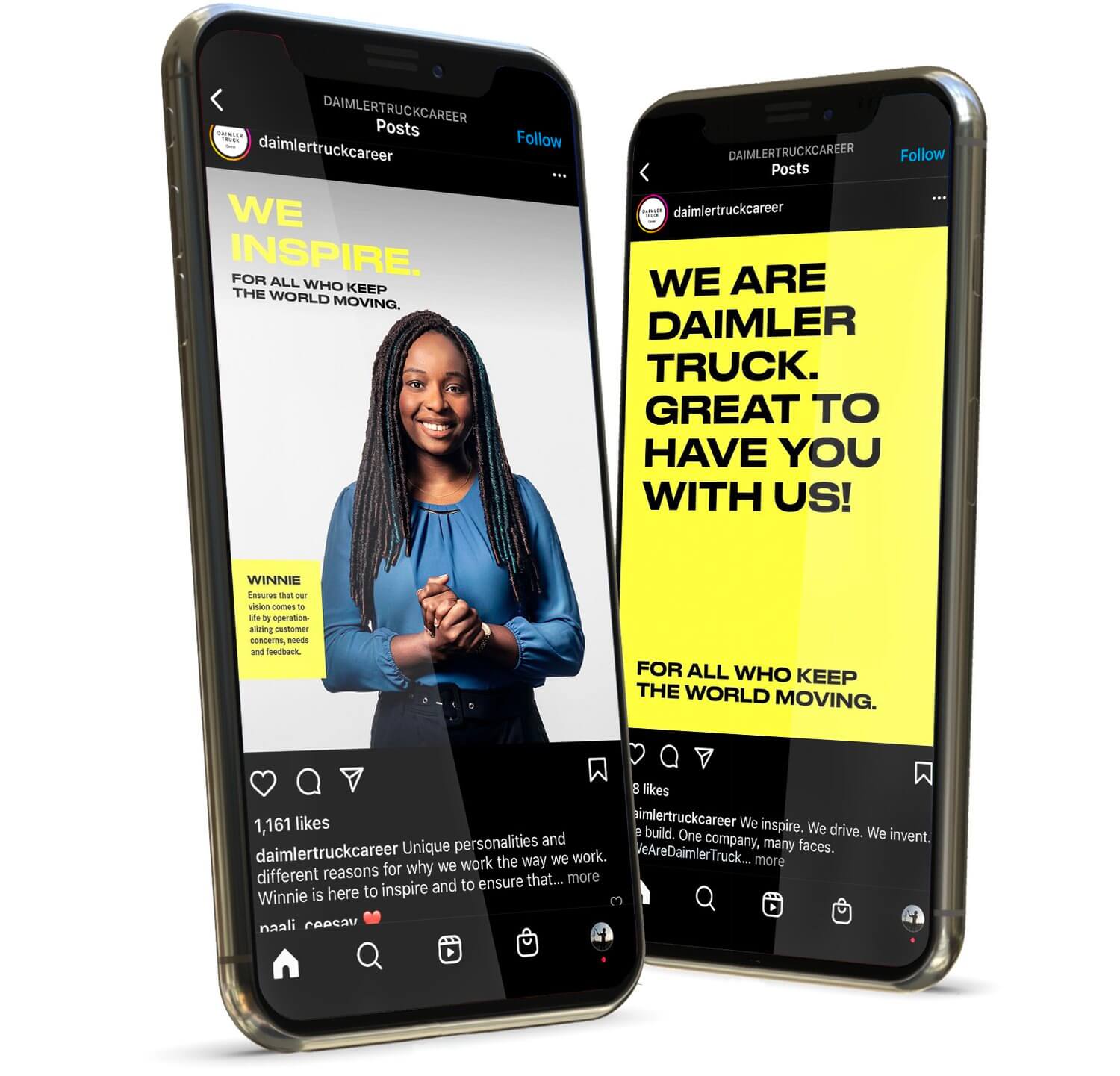Global unity for a family of brands
Daimler Trucks & Buses
A year-long creative journey to uncover and articulate a shared purpose for one of the world’s largest mobility brands.
More than just a line and statement of Purpose, it was an aligning of cultures, languages, and identities around a single idea that moved people inside and outside the company.
Global unity for a family of brands
Daimler Trucks & Buses
A year-long creative journey to uncover and articulate a shared purpose for one of the world’s largest mobility brands.
More than just a line and statement of Purpose, it was an aligning of cultures, languages, and identities around a single idea that moved people inside and outside the company.
Global unity for a family of brands
Daimler Trucks & Buses
A year-long creative journey to uncover and articulate a shared purpose for one of the world’s largest mobility brands.
More than just a line and statement of Purpose, it was an aligning of cultures, languages, and identities around a single idea that moved people inside and outside the company.



Unifying Purpose for a Global Family of Brands
This project was a year-long deep dive into brand purpose, creative strategy, and internal storytelling across Daimler’s constellation of global brands, including Mercedes passenger cars and Daimler Trucks & Buses.
It brought us from factory floors to strategy rooms, from test tracks to town halls; serving as creative director, facilitator, and sometimes translator across languages and cultures. It wasn’t just about marketing; it was about finding meaning that everyone could share.
Services
Brand Strategy: Brand Purpose, Investigation, Brand Pillars
Role: Creative Director.
Creative Team Leader, Creative Storytelling
Agency: BCG BrighthouseBCG
(As a Contractor on project)
Unifying Purpose for a Global Family of Brands
This project was a year-long deep dive into brand purpose, creative strategy, and internal storytelling across Daimler’s constellation of global brands, including Mercedes passenger cars and Daimler Trucks & Buses.
It brought us from factory floors to strategy rooms, from test tracks to town halls; serving as creative director, facilitator, and sometimes translator across languages and cultures. It wasn’t just about marketing; it was about finding meaning that everyone could share.
Services
Brand Strategy: Brand Purpose, Investigation, Brand Pillars
Role: Creative Director.
Creative Team Leader, Creative Storytelling
Agency: BCG BrighthouseBCG
(As a Contractor on project)
Unifying Purpose for a Global Family of Brands
This project was a year-long deep dive into brand purpose, creative strategy, and internal storytelling across Daimler’s constellation of global brands, including Mercedes passenger cars and Daimler Trucks & Buses.
It brought us from factory floors to strategy rooms, from test tracks to town halls; serving as creative director, facilitator, and sometimes translator across languages and cultures. It wasn’t just about marketing; it was about finding meaning that everyone could share.
Services
Brand Strategy: Brand Purpose, Investigation, Brand Pillars
Role: Creative Director.
Creative Team Leader, Creative Storytelling
Agency: BCG BrighthouseBCG
(As a Contractor on project)
The Challenge
From assembly plants to executive boardrooms to the drivers themselves
Daimler’s portfolio spanned continents and cultures. Each brand had its own legacy, audience, and way of speaking. The challenge was to bring these voices together under a single purpose that felt authentic to all of them, something that could live inside corporate strategy but also resonate with engineers, drivers, and factory teams around the world. How do you unify without erasing difference? How do you find a purpose strong enough to hold a family of brands together, yet flexible enough to speak every language?
The Challenge
From assembly plants to executive boardrooms to the drivers themselves
Daimler’s portfolio spanned continents and cultures. Each brand had its own legacy, audience, and way of speaking. The challenge was to bring these voices together under a single purpose that felt authentic to all of them, something that could live inside corporate strategy but also resonate with engineers, drivers, and factory teams around the world. How do you unify without erasing difference? How do you find a purpose strong enough to hold a family of brands together, yet flexible enough to speak every language?
The Challenge
From assembly plants to executive boardrooms to the drivers themselves
Daimler’s portfolio spanned continents and cultures. Each brand had its own legacy, audience, and way of speaking. The challenge was to bring these voices together under a single purpose that felt authentic to all of them, something that could live inside corporate strategy but also resonate with engineers, drivers, and factory teams around the world. How do you unify without erasing difference? How do you find a purpose strong enough to hold a family of brands together, yet flexible enough to speak every language?







The work
Helping to chart a course for a global brand for the years ahead
I was teamed with BCG and Daimler’s internal teams for a year long investigation and presentation process to lead a process that mixed listening, synthesis, and creative translation. Hundreds of interviews and workshops across markets revealed shared values. Innovation, pride, reliability, and motion. From those insights came a unifying purpose: “For all who keep the world moving.” It became a north star for storytelling, not a slogan to sell. A way to speak about technology, logistics, and human effort in the same breath. It shaped internal brand films, recruitment campaigns, social storytelling, and creative content across divisions. A digital series explored how purpose moves through people; from C-suite leaders to artists and athletes, showing that motion is both mechanical and human.
The work
Helping to chart a course for a global brand for the years ahead
I was teamed with BCG and Daimler’s internal teams for a year long investigation and presentation process to lead a process that mixed listening, synthesis, and creative translation. Hundreds of interviews and workshops across markets revealed shared values. Innovation, pride, reliability, and motion. From those insights came a unifying purpose: “For all who keep the world moving.” It became a north star for storytelling, not a slogan to sell. A way to speak about technology, logistics, and human effort in the same breath. It shaped internal brand films, recruitment campaigns, social storytelling, and creative content across divisions. A digital series explored how purpose moves through people; from C-suite leaders to artists and athletes, showing that motion is both mechanical and human.
The work
Helping to chart a course for a global brand for the years ahead
I was teamed with BCG and Daimler’s internal teams for a year long investigation and presentation process to lead a process that mixed listening, synthesis, and creative translation. Hundreds of interviews and workshops across markets revealed shared values. Innovation, pride, reliability, and motion. From those insights came a unifying purpose: “For all who keep the world moving.” It became a north star for storytelling, not a slogan to sell. A way to speak about technology, logistics, and human effort in the same breath. It shaped internal brand films, recruitment campaigns, social storytelling, and creative content across divisions. A digital series explored how purpose moves through people; from C-suite leaders to artists and athletes, showing that motion is both mechanical and human.







Global adoption
Unifying potential of Purpose in a family of global brands
The purpose platform was embraced by all and even took on a life of its own. Different markets translated and adapted it, finding cultural nuances that made it their own. From Japan to Brazil, each regional brand interpreted “For all who keep the world moving” in its own visual and verbal language; campaigns, internal activations, and local storytelling that connected global alignment with local authenticity. It became a shared creative framework that could flex, travel, and speak to everyone in their own words.
Global adoption
Unifying potential of Purpose in a family of global brands
The purpose platform was embraced by all and even took on a life of its own. Different markets translated and adapted it, finding cultural nuances that made it their own. From Japan to Brazil, each regional brand interpreted “For all who keep the world moving” in its own visual and verbal language; campaigns, internal activations, and local storytelling that connected global alignment with local authenticity. It became a shared creative framework that could flex, travel, and speak to everyone in their own words.
Global adoption
Unifying potential of Purpose in a family of global brands
The purpose platform was embraced by all and even took on a life of its own. Different markets translated and adapted it, finding cultural nuances that made it their own. From Japan to Brazil, each regional brand interpreted “For all who keep the world moving” in its own visual and verbal language; campaigns, internal activations, and local storytelling that connected global alignment with local authenticity. It became a shared creative framework that could flex, travel, and speak to everyone in their own words.







The outcome
Brand Purpose Pillars and resulting campaigns
The work gave Daimler’s global network a clear and human way to talk about itself internally and externally. It was instrumental in guiding internal communications, inspired new social and recruiting content, and gave brand teams across continents a reason to align around something that felt real. This wasn’t about launching a campaign. It was about helping thousands of people recognize that they were already part of one.
The outcome
Brand Purpose Pillars and resulting campaigns
The work gave Daimler’s global network a clear and human way to talk about itself internally and externally. It was instrumental in guiding internal communications, inspired new social and recruiting content, and gave brand teams across continents a reason to align around something that felt real. This wasn’t about launching a campaign. It was about helping thousands of people recognize that they were already part of one.
The outcome
Brand Purpose Pillars and resulting campaigns
The work gave Daimler’s global network a clear and human way to talk about itself internally and externally. It was instrumental in guiding internal communications, inspired new social and recruiting content, and gave brand teams across continents a reason to align around something that felt real. This wasn’t about launching a campaign. It was about helping thousands of people recognize that they were already part of one.



Get in touch!
We’d love to hear from you.
hello@fwbcause.com
© FWB Cause. All rights reserved.
Get in touch!
We’d love to hear from you.
hello@fwbcause.com
© FWB Cause. All rights reserved.
Get in touch!
We’d love to hear from you.
hello@fwbcause.com
© FWB Cause. All rights reserved.
